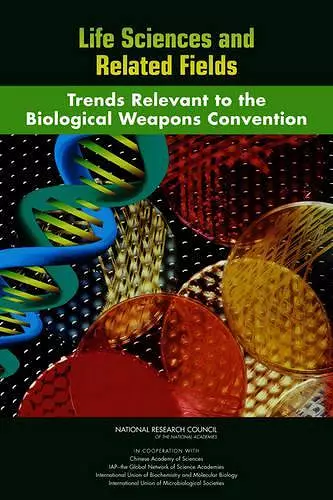Life Sciences and Related Fields
Trends Relevant to the Biological Weapons Convention
National Research Council author Division on Earth and Life Studies author Board on Life Sciences author Chinese Academy of Sciences author International Union of Microbiological Societies author International Union of Biochemistry and Molecular Biology author Committee on Trends in Science and Technology Relevant to the Biological Weapons Convention: An International Workshop author IAP—The Global Network of Science Academies author
Format:Paperback
Publisher:National Academies Press
Published:2nd Jan '12
Currently unavailable, and unfortunately no date known when it will be back

During the last decade, national and international scientific organizations have become increasingly engaged in considering how to respond to the biosecurity implications of developments in the life sciences and in assessing trends in science and technology (S&T) relevant to biological and chemical weapons nonproliferation. The latest example is an international workshop, Trends in Science and Technology Relevant to the Biological Weapons Convention, held October 31 - November 3, 2010 at the Institute of Biophysics of the Chinese Academy of Sciences in Beijing.
Life Sciences and Related Fields summarizes the workshop, plenary, and breakout discussion sessions held during this convention. Given the immense diversity of current research and development, the report is only able to provide an overview of the areas of science and technology the committee believes are potentially relevant to the future of the Biological and Toxic Weapons Convention (BWC), although there is an effort to identify areas that seemed particularly ripe for further exploration and analysis. The report offers findings and conclusions organized around three fundamental and frequently cited trends in S&T that affect the scope and operation of the convention:
- The rapid pace of change in the life sciences and related fields;
- The increasing diffusion of life sciences research capacity and its applications, both internationally and beyond traditional research institutions; and
- The extent to which additional scientific and technical disciplines beyond biology are increasingly involved in life sciences research.
The report does not make recommendations about policy options to respond to the implications of the identified trends. The choice of such responses rests with the 164 States Parties to the Convention, who must take into account multiple factors beyond the project's focus on the state of the science.
Table of Contents- Front Matter
- Summary
- 1 Introduction
- 2 The Pace of Developments in the Life Sciences
- 3 Diffusion of Life Sciences Research Capacity and Applications
- 4 Integration of Multiple Disciplines in Life Sciences Research
- 5 Monitoring and Assessing Trends in Science and Technology
- References
- Appendix A: Committee Member Biographies
- Appendix B: National and International Scientific Organizations Relevant to the BWC
- Appendix C: Workshop Agenda and Participants <
ISBN: 9780309210713
Dimensions: unknown
Weight: unknown
164 pages